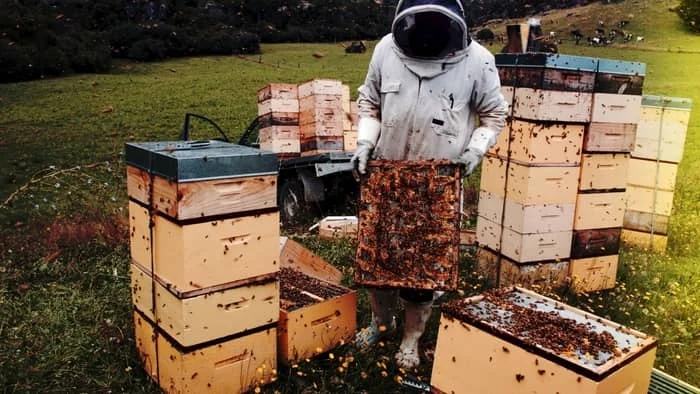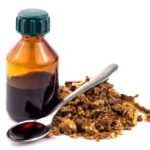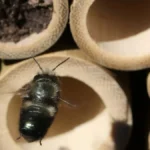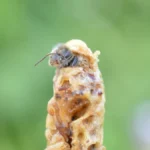A queen excluder is a sheet of material with holes in it. The holes allow workers, who are a little smaller, to get through, and the queen cannot. The queen excluder hole size is crucial to its functionality. In this article, we look at some basic queen excluder plans and how to make a DIY queen excluder. After exploring how to make an excluder, we look at whether the excluder is even necessary.
What Is A Queen Excluder?
A queen excluder is a sheet of material or a mesh with holes in it. The holes are sufficiently large that workers can just pass through. The queen is larger, and she is unable to pass through these holes. This is similar to the idea of bee space.
Why Do We Use A Queen Excluder?
A queen excluder can be used as a management tool to confine the queen to one or two brood boxes. This limits colony size and forces bees to store honey in the boxes above the excluder. It also reduces the risk of getting brood in your supers. This makes it easier to extract clean honey.
For short sharp honey flows, a queen excluder is important to ensure you get a crop of honey. Without an excluder, you would probably just get a crop of bees.
When performing bee removals we often have to move combs out of a natural hive and place them in a Langstroth box. Understandably this involves a big shock to the bees, and there is a tendency for relocated hives to swarm. Placing a strip of queen excluder over the entrance of the hive for a few days helps the queen decide to stay.
In warmer climates, bees will produce brood year-round. With bees endemic to these areas, a queen excluder allows one to force the bees to make honey rather than just manufacturing an endless line of swarms.

Beehive Queen Excluder Hole Size
This varies from the race of bees to the race of bees but generally, a distance between the wires of 0,163 inches (4.1mm) will work for your queen excluder hole size.
Some excluders can be a fraction larger, and with these, you will find the workers can get some pollen through into the supers.
Beehive Queen Excluder Plans
A queen excluder is a sheet of strong plastic or metal with holes cut in it. You can use several different materials based on the equipment you have access to produce a sheet with the right queen excluder hole size.
Old Designs
Sometimes you will find an excluder consisting of a series of metal rods with some sort of spacer and solder holding the whole lot together. I have found these to be infuriating and will not even waste space discussing them here. This may irritate some, and I apologize. Technology allows us now to move away from these older designs to less irritating, more efficient queen exclusion methods.
These old excluders make great bird excluders in your attic.
Metal
Stainless Steel
A thin (0,012 inch) sheet of stainless steel can be used. Grades 304, or 316 are useable. Cutting these with a laser cutter is relatively easy if you have the right unit.
Stainless steel is a strange material and does not favor being bent. With time it develops metal fatigue and parts of the excluder snap. If the bees you use produce a lot of propolis, rather use plastic.
Mild Steel
You can cut from thin mild steel sheets and will then need to get the sheets galvanized to prevent rust. I have a personal love-hate relationship with galvanized steel excluders as the metal tends to always deform and eventually let queens through.
Plastic
Many excellent plastic options exist. Plastic tends to be easier to pull away from brace comb and propolis and I find the holes do not deform as rapidly as they do with metal queen excluders.
ABS Plastic
Acrylonitrile butadiene styrene or ABS is a strong, scratch-resistant plastic that machines well with a variety of tools, including laser cutters and milling machines. An ABS plastic queen excluder will outlive you.
HDPE and PP
High-density polyethylene and Polypropylene plastic sheets are also excellent candidates for queen excluders. These inexpensive plastics allow you to produce heaps of excluders with a simple laser cutter should you so wish.
Metal Versus Plastic
Beekeepers are headstrong opinionated people. Some swear by metal queen excluders, some swear by plastic. All are right in their own way. The type of material you choose will be based on what race of bees you have, and what the natural environment in your area makes the bees do.
If you are in a warm climate with African/Africanised bees, you will find that metal excluders cause problems. To clean a metal excluder you need to heat it and wash it with warm water. To clean a plastic excluder, you roll it up, place an elastic band around it and freeze it. Remove the excluder from the freezer and unroll it and the wax and propolis break off quickly and easily.
If your bees are a race that does not produce a lot of propolis, such as many European bee races, a metal excluder is a perfect choice.
Learn more about: How Much Do Beehives Cost?
Cutting Your Excluder
Ideally, cut a series of rounded slots in your sheet of plastic or metal to get your queen excluder hole size right. The slots can be 1.5 inches long and 0,163 inches wide. If you are feeling fancy, try to round the edges of the slots.
Leave an edge at least 1 inch wide around the edge of the excluder. Commercial excluders do not do this, as they want the thing to get metal or plastic fatigue and break, forcing you to buy more. If you have a wide edge, it gives the excluder a lot more strength. You can also make the space between the slots equidistant or even a little larger, giving you more material to make your excluder strong.
I am convinced that commercial excluders are designed in such a way that they last the minimum amount of time needed. This has been my experience with all commercial excludes. Manufacturers will tell you that their designs are to aid ventilation. I have seen no evidence to back this up.
DIY Queen Excluder For Those Without Fancy Toys
I have over the years done a lot of beekeeping consulting work in developing countries. Africa and parts of South America are especially difficult regions to source equipment in. Things are either unavailable or expensive.
I was looking for something in a hardware shop and found this product. This works perfectly as a queen excluder and will cost you less than $1 a hive. It is indestructible. I have sheets that have lasted more than a decade.
In the US, multiple suppliers exist for these types of materials, which are marketed into the agriculture and aquaculture sector. The square or hexagonal shape of the holes means that even although a hole may be 4mmx4mm (which is a little smaller than 0,163inch) that bees can still get through the squares if they go through diagonally.
The best way to find this mesh is probably to go to your local hardware or garden stores armed with a caliper.
4mmx4mm mesh is never exactly that. The rollers and extruders get it wrong, and you will find if you look around you will find a roll where the factory was stretching things a bit and the mesh is 4.1mmx4.1mm which is perfect.
Queen Excluder YES Or NO?
Now that we have looked at the topic of how to make an excluder, we ask ourselves do we even need one?
The answer is quite simple – there will be times when you do, and times when you do not. This is always area-specific, season-specific, and bee race-specific.
Bees are complex animals, and the environment is a very complex thing as well. Queen excluders are a tool – as with any tool, there is a right time and a wrong time to use them. Experience shows us when to use tools. That is what makes us human.
You will have to find out from other beekeepers in your area how they manage their bees and experiment.
In my first eight years of beekeeping, we were in a climatic wet cycle. Queen excluders were not needed, and beehives produced 50-80 pound crops on average. Using a queen excluder actually reduced the crop. I believed that queen excluders were “flow excluders” and sniggered at the older beekeepers who used them.
A few years later, the climate entered a 7-year dry spell, and my honey yield dropped off rapidly. Using queen excluders allowed me to reduce hive populations, force honey production, and still get 50-80lb crops. Without excluders, my production was under 20lb a hive. I now understood the older beekeepers who used excluders.
Learn more about: When To Add Supers To Beehives?
Beehive Queen Excluder FAQs
What is the ideal queen excluder hole size?
The ideal queen excluder hole size is generally 0.163 inches (4.1 mm) wide. This allows worker bees to pass through while keeping the larger queen confined below.
Why is queen excluder hole size important?
The hole size ensures that only worker bees can access honey supers while preventing the queen from laying brood in those areas, which helps with honey extraction.
Can queen excluder hole size vary?
Yes, queen excluder hole size can slightly vary depending on the bee race. Some excluders have slightly larger holes to accommodate pollen throughflow into the supers.
What materials are commonly used for queen excluders?
Queen excluders are typically made from metal (like stainless or mild steel) or plastic (ABS, HDPE, or PP). Each material has its pros and cons depending on your bees and climate.
Which is better: metal or plastic queen excluders?
Both materials have their benefits. Metal is durable but can deform over time, while plastic is more flexible, easier to clean, and resists propolis buildup better.
Can I make a DIY queen excluder at home?
Yes, you can create a DIY queen excluder using metal or plastic sheets with correctly sized holes (4.1 mm). Laser cutters or hand tools can help with precision cutting.
Do I always need to use a queen excluder?
No, using a queen excluder depends on your beekeeping goals. In areas with short honey flows, excluders are useful to ensure honey production. In other cases, they may be unnecessary.
What are some common queen excluder plans?
Queen excluder plans typically involve cutting rounded slots 1.5 inches long and 0.163 inches wide from plastic or metal sheets. Leaving a wide edge helps with durability.
How do I clean a queen excluder?
For plastic excluders, freezing and flexing the material will remove wax and propolis easily. Metal excluders require heat and washing to clean effectively.
Is a queen excluder necessary in all climates?
In warmer climates with continuous brood production, queen excluders can help ensure honey storage. In cooler climates with shorter honey flows, they may not always be necessary.

Dr. Garth A. Cambray is a Canadian/South African entrepreneur and beekeeper with 28 years of experience in apiculture and specializes in adding value to honey. His Ph.D. research developed a new advanced continuous fermentation method for making mead that has resulted in a number of companies globally being able to access markets for mead. His company, Makana Meadery, exports honey mead to the USA where it is available to discerning connoisseurs. He has also developed technologies to commercially manufacture organic honey vinegar in Zambia for export globally. He holds a few patents globally in the ethanol industry and believes in technology and knowledge transfer for human development and environmental sustainability. One of his proudest achievements is the fact that the wind farm he started at one of his old apiary sites has essentially made his hometown carbon neutral.






